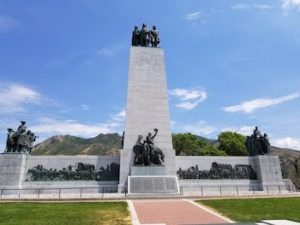
*On this date in 1827, we examine the Mormon church and American Slavery with a brief article. On this date, white Mormon Joseph Smith translated the Golden Plates (aka) the Book of Mormon into English.
The Latter-Day Saints Mormon movement has had varying and conflicting teachings on slavery. Early converts were initially from the Northern United States and opposed slavery, believing they were supported by Mormon scripture. After the church base moved to the slave state of Missouri and gained Southern slave-holding converts, church leaders began the practice. New scriptures were revealed, teaching against interfering with the slaves of others. A few slave owners joined the church and took their slaves with them to Nauvoo, Illinois, although Illinois was a free state.
In 1844, after Joseph Smith's death, the church split. The largest contingent followed Brigham Young, who supported slavery, allowing enslaved men and women to be brought to the West but prohibiting the enslavement of their descendants and requiring their consent before any move and became The Church of Jesus Christ of Latter-day Saints (LDS Church). A smaller contingent followed Joseph Smith III, who opposed slavery and became the Reorganized Church of Jesus Christ of Latter-Day Saints (RLDS). One of those families was Robert Marion Smith, who owned Biddy Mason, a black slave.
Young led his followers to Utah, where he led the efforts to legalize slavery in the Utah Territory. Young taught that slavery was ordained of God and that the Republican Party's efforts to abolish slavery went against the decrees of God and would eventually fail. He also encouraged members to participate in the slave trade in Native America. In the spring of 1847, the Mormons arrived in Utah during the Mexican-American War; they ignored the Mexican ban on slavery. Instead, they recognized slavery as a custom consistent with the Mormon view on Blacks.
The Compromise of 1850 passed in Congress gave a choice of bondage between Southern slave-holding interests and free states. One of those states was Utah. Many prominent church members were slave owners, including Abraham O. Smoot and Charles C. Rich. When the American Civil War broke out, some Mormon slave owners returned to southern states because they worried they would lose their slaves.
On June 19, 1862, Congress prohibited slavery in all US territories, and on January 1, 1863, Abraham Lincoln issued the Emancipation Proclamation. The slaves of the Mormons met the news, and many left Utah for other states, particularly California. After the slaves were freed, Young gave several discourses on slavery. He characterized himself as neither an abolitionist nor a pro-slavery man. He criticized the South for abusing slaves and the North for their alleged worshiping of Blacks. He opposed the Civil War, calling it useless and saying that the "cause of human improvement is not in the least advanced" by fighting such a war.
He predicted the Emancipation Proclamation would fail. According to W. Paul Reeve, Brigham Young was the driving force behind the 1852 legislation to solidify slavery in the Utah territory, and the common fear of "interracial mixing" motivated Young. Reeve explains that while Joseph Smith saw potential for black equality, Young believed blacks were inferior to whites by divine design. It took over one hundred years for the Mormon church to allow Black priesthood in LDS.